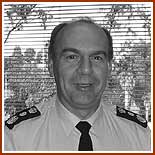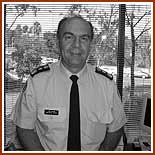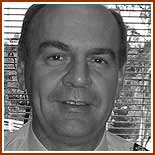
|
|
 "I remember hiking up to a place called Morganís Mill. I used to sit there and look at this isolated sawmill and Iíd think about what it was like for those people in 1939."  "The pioneering aspect of breaking out into the bush and claiming more land was part of Australiaís in-built folklore. Those people were very, very tough indeed."  "The mining industry of course needed heaps of timber and the transport industry was so rudimentary that the people had to go to the bush."  "Unlike the í83 fires there is very little film footage of Ď39, so a lot is left to your imagination."  "I think that fire is in the Australian psyche. We actually believe that bushfires are part of Australia, that itís one of the things that distinguishes us from other countries." |
Russell Rees CFA Chief Officer  My experience and knowledge of 1939 comes from a number of places. First of all anybody who studied the history of CFA would understand that the CFA came as a result of the Royal Commission following the fires of 1939. But as a young boy growing up, I can just distinctly remember my father talking to me about his involvement in 1939, where he was an employee of the SEC and he told me about the number of workers who went from the SEC to fight fires around Erica in 1939. And so I had this memory of him telling me stories of what happened in 1939 and he married quite late and in fact he would have been in his 30ís in - he was born in 1902 so he would have been 37-38 around that time - and he told me about the severity of the fires and how basically everything was on fire. The other thing that really strikes me in my memory is that as a young boy growing up in the La Trobe Valley, I was in Scouts and we would go camping at a place called Tyers Junction which is a place at the bottom of Mt. Erica and of course Erica and that part of the world from Noojee right across was devastated in the fires and I can always remember the grey sticks of the mountain ash that were the remains of 1939. But the other two things I remember: first of all, at that scout camp was a dug-out. It was a logging base and there was a dug-out and we used to always go in to that dug-out when we went camping and look at the fireflies on the wall and we used to talk and think about what it would be like being in there if there was a fire, because thatís what it was built for. The other thing we used to do was go hiking up to a place called Morganís Mill which was a place up the western Tyers branch - Tyers Junction. The river breaks in three ways and we used to follow the logging tracks of all the little tramways and that and wander up there and I used to sit there and look at this isolated sawmill and Iíd think about what it was like for those people in 1939. They were miles from nowhere, they couldnít get out, and I'd think, what it would have been like for those people and I think that Morganís Mill was one of those places, and certainly the area all around Erica, which was severely affected by fire in 1939. I would think about what it would have been like for the sawmill industry because unlike the centralised population of today, in 1939 the communities were a lot more dispersed, there were people actually living right in the middle of the bush.  They didnít travel into the bush like they do now. If you were a timber
cutter now, you might hop into your ute and drive into the bush to do your work for the
day. Well in those days, they actually lived in the bush, thatís why so many were killed and didnít survive. They didnít travel into the bush like they do now. If you were a timber
cutter now, you might hop into your ute and drive into the bush to do your work for the
day. Well in those days, they actually lived in the bush, thatís why so many were killed and didnít survive.In essence itís because that was the industry of the countryside and there was a certain probably pioneering thing about in the bush. The Australian thing about people being in the bush and surviving and doing it tough and also, part of the timber industry was about the growth of the nation I suspect. I think there was that sort of history that went along with it and the pioneering aspect of breaking out into the bush and claiming more land. It was part of Australiaís in-built folklore, that sort of life and it was somehow very, very adventurous and those sort of people were tough. Youíd have to regard them I think as being very, very tough indeed. Well, I can only go on what my father said to me. My father grew up on the land and he lived through the depression and during the depression and the drought he left the farm, basically walked off the farm and he and his brother went to the La Trobe Valley because the SEC was the only place where they could get work and perhaps it needs to be looked at in the light of what came before, in terms of Australiaís history coming out of the war into the depression and people were, it was tough, but it was a living, and thatís why people did it, because they were good with their hands, the timber was vitally important. Not only was the work there but it was one of the pieces of the jigsaw that went toward building a community - having something to build a house out of and indeed something to run an industry from. The mining industry of course needed heaps of timber, and the transport industry was so rudimentary that the people had to go to the bush; the bush couldnít come to the people.  I think it was the enormity of it. The fact that unlike even í65, í69, í77, or the í83 fires there is either very little film footage or none at all, so a lot is left to your imagination, a lot is left to what is written, the enormity of it across the state, the fact that it was actually a culmination of a lot of fires that had been burning for a lot of days. I think it was the enormity of it. The fact that unlike even í65, í69, í77, or the í83 fires there is either very little film footage or none at all, so a lot is left to your imagination, a lot is left to what is written, the enormity of it across the state, the fact that it was actually a culmination of a lot of fires that had been burning for a lot of days.I mean the assumption always is that they all blew up on the one day, well thatís not actually true. There were fires burning all over the place, and some of them coalesced into large fires and some of them were just large fires in their own right and they just had a blow- up day with a number of very severe days before it. I think that fire is in the Australian psyche and the whole thing about Australian bushfires, is that we actually believe that bushfires are part of Australia, that itís one of the things that distinguishes us from other countries. The other thing is for me, and certainly for the fire industry, is that it was a turning point in terms of structure and arrangement for fire prevention and fire suppression because when you look at the model which was proposed as a result of the 1939 Royal Commission - which didnít get activated on ítil 1944 following another lot of severe fires - if you look at that model, that model has not only stood the test of time, but when you compare it to other models, in other states, was light years ahead. The understanding that there should be an authority that took charge of the overall business of fire, that there should be control over the lighting of fire, that there should be a process of declaring severe days - and I think that terminology talked about acute fire danger days rather than days of total fire ban - that there should be a linkage between the land management agencies in those days the Forest Commission and the fire service. And for me, it has made it very significant because it was the birth of CFA. It gave us those twin tenets of prevention and suppression as being equally important and completely changed the approach that previously had said that bushfire brigades were just little unimportant things in the business of management of fire in Victoria. Because they were very poor, under-funded and lacked legislation. The Forestry Commission had basically controlled the agenda. The Forestry Commission had a very distinct and direct reason for being, and that was to produce timber. They were not in the game of dealing with fire in terms of country Victoria, and so the 1939 fires really focused Victorians as to what it was all about. Read more about the formation of the Country Fire Authority in 1939 in the Royal Commission section |
The FireFighters
Len Foster
Chairman and CEO of the Australasian Fire Authorities Council Gary Morgan Chief Fire Officer for the Department of Sustainability and the Environment Russell Rees CFA Chief Officer Allan Marks CFA Group Officer for the Dandenong Ranges Fire Brigade Group Greg Head CFA Captain of the fire brigade in Warburton John Rigby Coordinating chaplain for the Country Fire Authority Mike Leonard Manager of Strategic Planning - Fire Management, at the Department of Sustainability and Environment John Masterton Burns surgeon. Head of the Burns Unit at the Alfred Hospital from 1967 - 1996. |
 |